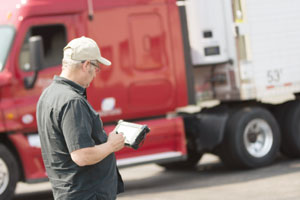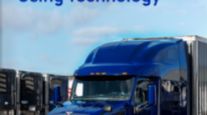Developers of Fleet Management Systems Balance Needs of Expert, Novice Users

By Dan Calabrese, Special to Transport Topics
This story appears in the June 15 print edition of Transport Topics.
Fleet management programs are packed with features that can help carrier executives run their businesses, but many only scratch the surface of the technologies’ capabilities, industry and software executives said.
“You’re going to find a variety across fleets,” said Randy Boyles, senior vice president of tailored solutions at software firm PeopleNet, in Minnetonka, Minnesota. “With every software package — everything I’ve been involved with throughout my career — you’ll find people who explore everything to the ‘nth’ degree, and they’ll find certain features are not what they want to use. There are other people who will latch onto something, and that’s all they do.”
“The more sophisticated you are, the more I think people utilize,” said Houston Vaughn, chief operating officer for P&S Transportation, in Ensley, Alabama, which uses programs from technology supplier McLeod. “It’s just like an Excel spreadsheet; there are certain parts you don’t use in an application. A smaller carrier that’s less sophisticated might have a system, but they don’t really know how to use the system. We probably utilize [85% to 90%] of it.”
Technology vendors must strike a balance between offering enough capabilities to satisfy fleets’ varying needs while not overloading their products with excessive features that might inflate the price. They know that their programs must address a real need or solve a real problem.
“If I took the average [customer service representative], planner, dispatcher, drive manager, billing clerk, settlement processing person — those people’s lives are [99%] spent inside those functional areas,” said Mark Cubine, vice president of marketing for McLeod Software. “There are all these things around the edges where you have the most advanced users getting the most use of advanced automation. And then there are the simplest users, who are just doing the basics. If I pick the top [10%], they’re doing twice as much as the bottom [10%].”
One reason usage differs from fleet to fleet is disparity on what constitutes back-office operations. Fleets interviewed for this story all had their own definitions: for some, it’s administration and billing only; for others, customer service and sales; while still more see maintenance and driver route management as back-office functions. But there was agreement that use of technology is determined largely by how their organizations are structured.
“Most advanced users on the customer service and sales side, their outside people are using the customer relationship management functions in our system,” Cubine said. “Before they walk out the door, they know everything about that customer. They’re going to take their Droid or their tablet and look that up.”
On the finance side, fleets want help with managing their money and with making more of it, said Vikas Jain, COO for Seattle-based Zonar Systems.
“Fleets want effective hours-of-service reporting and monitoring that can provide data not only to fleet managers to monitor for compliance but also to clerks in the company’s billing department so they can track transit and delivery times for more accurate billing,” he said, citing fuel-tax reimbursement as an example.
“Effective telematics can provide them and their tax consultants the ability to automatically monitor and track fuel usage to determine fuel-tax reimbursements in different states,” he said.
Telematics is a broad term for systems that monitor trucks’ and trailers’ mechanical and electrical functionality and are another component that fleets look for in the technology suites, Jain said.
“When their trucks develop mechanical issues while out on the road, fleet managers want to know with a much greater degree of certainty that their shop or maintenance vendor’s mechanics will know about them, even if their drivers don’t immediately report them,” he said. “Fleets are looking for telematics providers who can provide systems that automate that process.”
And that includes systems that can help companies spec’ technology that will send specific maintenance alerts, PeopleNet’s Boyles said.
“Other areas that get used a lot are configuring vehicles, because the hardware/software devices can be configured to alert or alarm on different conditions,” he said.
Fleets also are looking for ways to keep a closer watch on drivers.
“The big usage is with electronic driver log management and reporting because, in some cases, there are things you can only do through our system, so that kind of locks you in there,” Boyles said.
That includes the functions of an onboard event recorder, which can record items such as sudden starts and stops, or events related to rollover stability.
“I think the things people are continuing to push for involve mapping and routing,” Boyles said. “We, of course, do that, but there are so many other things that you can do better, and as time goes on, today we can really tell a driver the best route to take, but as you go forward, you’re really wanting a real [estimated time of arrival] and a system that takes into account your traveling speed — constantly recalculating and looking at the route you’re taking. All of that is there today.”
With so many approaches to technology usage and many fleets using only portions of the systems they buy, the notion of customized systems — which are available — might seem sensible. But one trucking industry executive cautioned against building something that is too specific to one’s operations.
“Anything you customize this time around may potentially need to be customized again anytime new features come out,” said Christopher Hummer, president of Don Hummer Trucking, based in Oxford, Iowa. “So we’ve taken a different approach, which is that just because this is on the wish list doesn’t mean we’re going to go ahead and change it immediately.”
But fleets that do not explore all that is already built into the programs could be missing out on opportunities, Zonar’s Jain said.
“One of the most key ingredients fleets may or may not realize they need from telematics providers is a higher level of quality data,” he said. “While they may not recognize its importance, anytime fleets experience large gaps within their reports — anywhere from several minutes to several hours of missing information, they have been impacted by inferior data.”
And capturing the data most important to that fleet is the key service software should provide, Hummer said.
“You have to figure out which products can make a difference, as opposed to which ones just look cool in the sales demo,” Hummer said. “You can see what they could do, but you’ve got to right-size those things in your operation, and the biggest thing is making sure you understand how they’re going to work before you put them in place. You have to make a lot of choices, and how you make those choices can affect your usability for years to come.”




